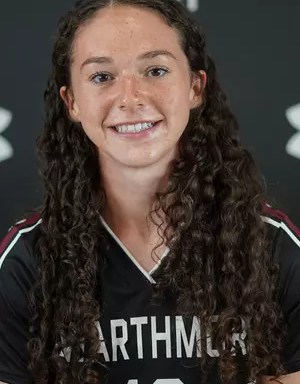I grew up, like most current or former collegiate athletes, playing high-level soccer and feeling immense pressure to perform. My sport became deeply tied to my sense of being, my personal worth, relationships, and how I thought others viewed me. As a woman, that weight carried an added, nuanced layer: the constant gazes, the acute awareness of my body in motion, of small Nike shorts and knee-high socks, and of how easily confidence could dissolve into self-consciousness.
Of course, there are many reasons that athletes face mental health challenges: anxiety, eating disorders or disordered eating patterns, body dysmorphia. But I do not think it is a coincidence that female athletes experience these pressures, both sport-specific and societal, at an increased rate. I am not citing any empirical statistics here, only my own lived experience, in hopes that someone might find solace in a shared challenge.
When I joined the Girls Development Academy (GDA) in ninth grade, I moved soccer clubs in North Carolina to play more competitive sports. That is when I first began having what I now recognize as anxiety attacks: crying, nausea and vomiting, shortness of breath before every game and most practices. This was a stark break from the joy I once felt playing travel soccer as a younger person. Now that I am no longer competing as a collegiate athlete, I often look back and wonder how much my younger self endured without the language to name or speak it to others.
One of the first sources of hardship was my former coach, who was also the head of the National Women’s Soccer League NC Courage team, who would routinely touch and inspect the length of our shorts and tell us to “pull them down,” physically scrutinizing our clothing choices. After one of my showcase games, in front of collegiate scouts, he said that my teammate and I could never wear makeup again because our rain-smeared mascara made us look “ridiculous and unprofessional.” This same coach was not immune to calling girls “bigger” or “unfit” and was speculated to have dated former players. This is not to slander his name or strip him of the title of a great technical coach, which he was, but to show the habituation of this style of coaching. Most, including myself, would not bat an eye at these behaviors because of the normalization, even the acceptability of it in popular culture antics, especially while coaching girls.
Along with this, my GDA team shared facilities, fields, and locker spaces with the Boys Development Academy (BDA), our club’s male counterpart. We crossed paths with these players frequently and between my coach’s comments and the attention from teenage boys, many of us felt constantly sexualized, even as young, thirteen year-old girls.
It was at this age that I became close with some of the BDA players, including someone who later assaulted me at a teammate’s house. Writing this feels a bit surreal, but honesty demands it. The overlapping cultures of scrutiny, objectification, and a lack of clear boundaries in youth sports, predominantly youth-female sports, create environments where girls are routinely vulnerable, without protection or fair recourse.
And this experience is not mine alone. From high school to club to college to professional sports, there are countless horrific stories of female athletes enduring visceral mental, verbal, or sexual abuse. The problem is not limited but systemic.
When young women and girls can grow up seeing themselves in positions of leadership, power, and authority it can alter what one thinks is acceptable and possible. It can reshape conceptions of confidence and the power dynamics that often undergird sports and leave athletes feeling vulnerable and voiceless. I think often about what it would have meant for me, as a thirteen- or fourteen-year-old girl terrified to get subbed into a game, to have had a coach see me as a struggling young girl, not merely a body for critique or control.
Through the process of writing this there is healing, but also a shared responsibility: we owe it to the next generation of young female athletes to cultivate spaces to grow confidence and a true sense of self that does not come at the cost of personal safety. Women’s athletes deserve more than survival: they deserve abundances of joy, respect, and safety because, after all, it is supposed to be just a sport.

















Thank you for your vulnerability and courage, Katherine. Such an important article for our athletes and coaches (male and female) to read. -Jorge Aguilar ’05 (Sport Psychiatrist)
Katie, this is incredibly well-said. Growing up, I avoided sports altogether because of what you describe in this piece – heavy emphasis on the over-sexualization and insults levied against girls who don’t subscribe to a specific athletic ideal. It begs the question of who decides upon these criteria, and why we choose to pick apart women based on their appearance. Moreover, why are we judged for our looks over our performance? Thank you for treating this subject with the care it deserves.
Katie,
I appreciate you sharing this <33 The fact that you have experienced this is insane and shouldn't be normalized.
I am hoping you continue to heal.
Always here for an ear.